| Origami Heaven A paperfolding
paradise
The website of
writer and paperfolding designer David Mitchell
x
|
| |
| Analogues of the Cube |
| |
| There
are two different kinds of analogues in modular origami,
surface analogues and method analogues. Surface analogues are
modular forms whose outer surfaces are distortions of
each other (though the two forms can not necessarily be
continuously distorted into each other in a mathematical
way).
Method analogues
are designs which share the same modular method.
The forms in the
three sections below are all surface analogues of the
cube (and thus of each other). Within the sections the
designs are also method analogues of each other.
This page only
shows a small selection of the known cube analogue
designs.
|
| |
| Method
Analogues of the 1- Fold Cube |
| |
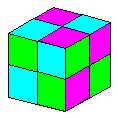 |
|
Name: The 1-Fold
Cube - a design that can be loosely
constructed on a flat surface but is not
sufficiently stable to be picked up. It is
therefore more of a multiple-piece than a modular
design, but I include it here for the sake of
completeness. Modules / Paper shape / Folding
geometry: 12 minimalist modules from squares
using standard folding geometry.
Designer /
Date: Kenneth Kawamura, 1977.
Diagrams:
Diagrams were published in Kenneth Kawamura's
booklet 'Meditations on a Waterbomb' in 1977.
|
|
| |
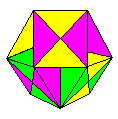 |
|
Name: The Butterfly
Ball Modules / Paper shape / Folding
geometry: 12 very simple modules from squares
using standard folding geometry.
Designer /
Date: Kenneth Kawamura, early to mid 1970s.
Diagrams:
Diagrams were published in Kenneth Kawamura's
booklet 'Meditations on a Waterbomb' in 1977.
|
|
| |
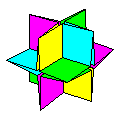 |
|
Name: XYZ
(12-part) - a twelve module
version of Ed Sullivan's classic 6-part XYZ
design. Modules / Paper shape / Folding
geometry: 12 modules using standard folding
geometry.
Designer /
Date: Independently discovered by at least Robert
Neale, Michael Naughton and David Mitchell in the
late 1980s. I do not know who has creative
priority.
Diagrams:
Diagrams can be found in Paper Crystals (2nd Edition) -
Water Trade - ISBN 978-0-9534774-9-4.
|
|
| |
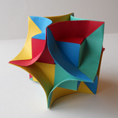 |
|
Name: Enigma Cube (12-part ) Modules / Paper
shape / Folding geometry: 12 modules from squares
using standard folding geometry.
Designer /
Date: David Brill, 1988.
Diagrams:
In Paper Crystals - David Mitchell - Water Trade
- ISBN 9780953477494.
|
|
| |
| Method
Analogues of the Blintz Cube |
| |
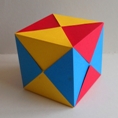 |
|
Name: The Harlequin Cube Modules / Paper
shape / Folding geometry: 6 modules from squares
using standard folding geometry.
Designer /
Date: Kenneth Kawamura in the early 1970's.
Diagrams:
On-line diagrams are available on the Modular Designs page of this site.
|
|
| |
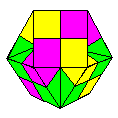 |
|
Name: The Windmill
Base Cuboctahedron - so named because
the modules are obtained by partially opening out
the folds of a standard windmill base. Modules / Paper
shape / Folding geometry: 6 modules from squares
using standard folding geometry.
Designer /
Date: I discovered this design in 1989. It has
also been discovered by Michael Naughton. I do
not know which of us has creaative priority.
Diagrams:
Not yet available.
|
|
| |
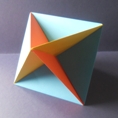 |
|
Name: Robert Neale's
Octahedron, Skeletal Octahedron or
Nolid Octahedron Modules / Paper
shape / Folding geometry: 6 modules from squares
using standard folding geometry.
Designer /
Date: Robert Neale, mid 1960s. Many other
paperfolders have independently originated this
design , including Kunihiko Kasahara, also in the
mid 1960's, slightly later than Robert Neale but
on the other side of the world, and Joe Power, in
Hawaii, sometime in the early to mid 1970's.
Incorrectly attributed to Seiryo Takegawa in
Origami Christmas Tree Decorations, Paul Jackson,
BOS booklet 20, 1982.
Diagrams:
On-line diagrams are available on the Modular Designs page of this site.
|
|
| |
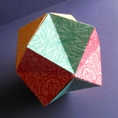 |
|
Name: The Harlequin Star aka
Blue Balloon / Epsilon Star Modules / Paper
shape / Folding geometry: 6 modules from squares
using standard folding geometry.
Designer /
Date: Kenneth Kawamura, early to mid 1970s.
Robert Neale also independently discovered this
design at an early date. I do not know who has
creative priority.
Diagrams:
On-line diagrams are available on the Modular Designs page of this site.
|
|
| |
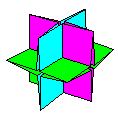 |
|
Name: XYZ Modules / Paper
shape / Folding geometry: 6 modules from squares
using standard folding geometry.
Designer /
Date: Ed Sullivan, 1976.
Diagrams:
Published in The Flapping Bird issue 25 in 1976.
|
|
| |
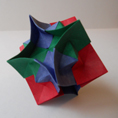 |
|
Name: Enigma Cube (6-part) Modules / Paper
shape / Folding geometry: 6 modules from squares
using standard folding geometry.
Designer /
Date: David Mitchell, 1988.
Diagrams:
In Paper Crystals - David Mitchell - Water Trade
- ISBN 9780953477494.
|
|
| |
| Method Analogues of Paul
Jackson's Cube |
| |
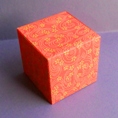 |
|
Name: The
Paul Jackson Cube. Modules / Paper
shape / Folding geometry: 6 modules from squares
using standard folding geometry.
Designer /
Date: Paul Jackson, early 1970's.
Diagrams:
On-line diagrams can be found on the Modular Designs page of this site..
|
|
| |
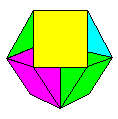 |
|
Name: The Paul
Jackson Cuboctahedron - produced by
inverting all the corners of the Paul Jackson
Cube to the mid-point of each edge. Modules / Paper
shape / Folding geometry: 6 modules from squares
using standard folding geometry.
Designer /
Date: Paul Jackson, shortly after discovering his
eponymous cube, in the early 1970s.
Diagrams:
Not yet available.
|
|
| |
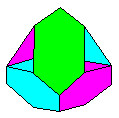 |
|
Name: The Tetracube
- which lie at the corner of one of the
tetrahedra that could be inscribed within it.
Unlike the Columbus Cube the Tetracube is a
regular modular design. The Tetracube will also
act as a macromodule. Modules / Paper
shape / Folding geometry: 6 modules from squares
using standard folding geometry.
Designer /
Date: David Mitchell, 1990.
Diagrams:
In Building with Butterflies - David Mitchell -
Water Trade - ISBN 978-0-9534774-7-0.
|
|
| |
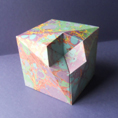 |
|
Name: Metamorphosis
- arrived at by applying the
metamorphosis 1 distortion to one complete corner
of the Paul Jackson Cube. Modules / Paper
shape / Folding geometry: 6 modules from squares
using standard folding geometry.
Designer /
Date: David Mitchell, 1990. In its final clean
form the design is my own but it owes much to the
earlier work of Iris Walker, Ricky Wong and Wayne
Brown.
Diagrams:
In Building with Butterflies - David Mitchell -
Water Trade - ISBN 978-0-9534774-7-0.
|
|
| |
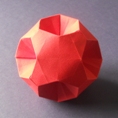 |
|
Name: Paper
ball - a robust ball made by distorting
all six corners of the Paul Jackson Cube. I made
the ball in the picture in 1989 and have played
keep it up tennis and catch with it on several
occasions since. As you can see, it has survived
quite well. Modules / Paper shape / Folding
geometry: 6 modules from squares using standard
folding geometry.
Designer /
Date: David Mitchell, 1989.
Diagrams:
Not yet available.
|
|
| |
| Method Analogues of the
Sonobe Cube |
| |
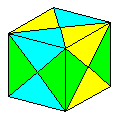 |
|
Name: The Sonobe Cube Modules / Paper
shape / Folding geometry: 6 modules from squares
using standard folding geometry. Cubes made from
larger numbers of modules are also possible.
Designer /
Date: Mitsonobu Sonobe, c1965.
Diagrams:
On-line diagrams are available on the Modular Designs page of this site.
|
|
| |
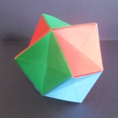 |
|
Name: The Sonobe 6-part
8-point Stubby Star / Convertible Cube Modules / Paper
shape / Folding geometry: 6 modules from squares
using standard folding geometry. Stubby Stars
made from larger numbers of modules are also
possible.
Designer /
Date: David Mitchell, early 1990s.
Diagrams:
On-line diagrams are available on the Modular Designs page of this site.
|
|
| |
| |
















